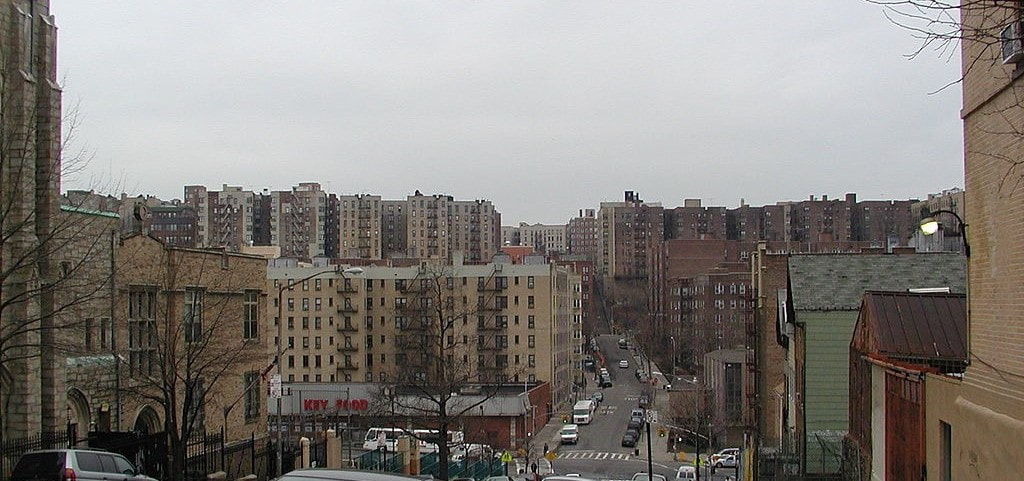|
By Deborah Harley There is a moment in Lin-Manuel Miranda’s new film In the Heights when a young woman asks a Washington Heights resident for neighborhood directions. She reluctantly confesses that she has never been above 96th Street. That is so true to life! Many New Yorkers have not ventured north of the Upper West Side or Upper East Side of Manhattan. The neighborhood that Miranda showcases, Washington Heights, may be the most New York place in Manhattan in that it has long been a neighborhood of immigrants, a community of dreams. Before the Dominicans made it their home, many other ethnic groups made it their refuge. One of the largest groups was German Jews. They were so dominant in the neighborhood in the mid-twentieth century that researcher Steven M. Lowenstein wrote a book in 1989 about them that he titled Frankfurt on the Hudson. Washington Heights, looking west on 187th Street. The Key Food grocery store (red lettering) is on Broadway, the de facto dividing line between the Jewish neighborhood to the west and the homes of other ethnic groups. (Photo by Petri Krohn at the English Wikipedia, cropped) Northern Manhattan is newly settled compared with the rest of the island. In fact, the 1811 street grid, which created the system of numbered streets and avenues, did not extend beyond 155th Street because at the time it was thought that nobody would ever live that far north. But slowly residents came. Late in the nineteenth century, it was the exclusive domain of affluent New Yorkers who built fantastic mansions and picturesque castles along the majestic Hudson River cliffs. Once the subway expanded to 157th Street in 1904, new waves of residents started to settle in the area. Most of the residents were of European origin, including East European Jews. After Adolf Hitler gained power in Germany in 1933, many of that nation’s 523,000 Jews started leaving Germany. By the end of 1941, when the Nazis shut the door on Jewish emigration, only 163,000 Jews remained. Most countries were closed to the Jewish refugees. The United States accepted only 125,000, and about half settled in New York City. Those from northern and urban Germany favored the Upper West Side and Queens, while refugees from southern Germany and rural areas—approximately 20,000—chose Washington Heights. The Heights provided an established community for the newcomers, and the 1932 subway expansion to Inwood opened up additional housing possibilities. Aufbau, a New York-published global periodical for German-speaking Jews, regularly advertised apartments in Washington Heights. Families had their pick of large apartments. Other German Jews chose to rent rooms in apartments, which sometimes included meals. By 1940, about a third of Washington Heights residents were German Jews. A dozen new synagogues were built in the Heights between 1935 and 1949. German Jews were not the only immigrant group settling in Washington Heights in the mid-twentieth century. Irish people, Armenians, Greeks, and Russians all laid claim to small enclaves. The main dividing line, as it still is today, was Broadway. German Jews settled predominately west of Broadway between the West 150s and the West 180s; members of other immigrant groups settled east of Broadway. As German Jews established their lives and careers, they started moving out of the Heights to the suburbs and to more affluent urban neighborhoods, such as Riverdale in the Bronx. At the same time, Harlem residents and new immigrants from Puerto Rico and Cuba moved into the area because of the large, affordable residences. By 1950, one third of the residents of Washington Heights were Black and Hispanic. The remaining German Jews and other residents of European descent congregated near Fort Tryon Park, where they still live today. But children of the German-speaking settlers often had become Americanized and opted to leave the neighborhood that their parents had chosen. In 1960, German-speaking Jews accounted for sixteen percent of the residents of the Heights; by 1980, they were only eight percent. By the mid-1960s, the Heights saw an influx of Dominican residents. They began to redefine the area with their churches, shops, music, and culture. Since then, Washington Heights has become the largest Dominican community in the United States. The Heights is no longer nicknamed Frankfurt on the Hudson. It is now widely known as the Little Dominican Republic. That’s the community that In the Heights celebrates (although some characters in the film report Puerto Rican and Cuban roots). For Additional Information In February 2020, the Leo Baeck Institute opened an exhibition in Chelsea telling the story of German-speaking Jewish refugees in Washington Heights. The exhibit was called Refuge in the Heights: The German Jews of Washington Heights. Unfortunately, it wasn’t open long, as it was forced to shut down because of the COVID-19 pandemic. However, the exhibit can be seen virtually at https://www.lbi.org/exhibitions/virtual-refuge-heights. Another excellent and entertaining source of information about German refugees and the Heights is a recent documentary, available on Hulu, about Dr. Ruth Westheimer, titled Ask Dr. Ruth. By the way, Dr. Ruth still lives in Washington Heights—near Fort Tryon Park. Tours Now that the city is coming back to life, we are again offering walking tours. We also have created some virtual tours, offered on Zoom; most of them are adaptations of our in-person walking tours. These are our virtual tours:
Please contact us at [email protected] to learn more about our walking tours and virtual tours. Comments are closed.
|
Archives
April 2024
|


